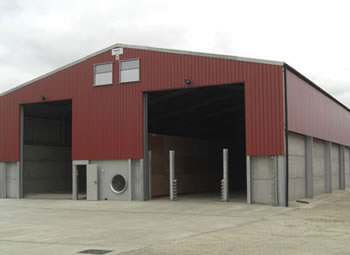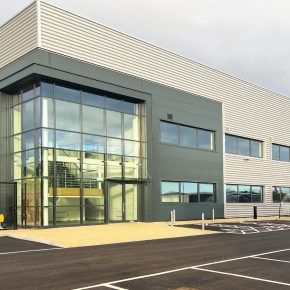
Business expansion – are timber or steel buildings the best?
Pros of timber frame construction
Timber buildings boast numerous environmental and economical benefits over steel constructs.
Andrew Dunn, Chief Executive of the Timber Development Association recently stated: Timber has no disadvantages, only design challenges. The key aspect for timber is that its properties are well known and very predictable.
A wide range of timber options are naturally durable, adaptable and lighter in weight compared to other materials that can be used for building expansion, as well as being easier to self-repair and maintain.
In addition to having a higher structural efficiency per unit weight compared to steel, the common timber stud used in housing construction benefits from comparable compressive strength to concrete.
Timber building
As for environmental benefits, timber is a better insulator than steel, coping much better in sub-zero temperatures.
Furthermore, reclaimed timber can be used to maintain a limited carbon footprint – and if the reclaimed option is not viable, the majority of structural timber is sourced from sustainably managed forests and plantations.
Timber used on the internal frame of a building will also provide a healthier environment for occupants too, as it helps to maintain a better relative humidity.
Cons of timber frame construction
However, in addition to the obvious fire risks associated with timber constructs, timber frames are potentially susceptible to damage from both terminate infestation and internal surface stress fractures, both of which can yield substantial damage and costs if not prevented and monitored.
Furthermore, in damp conditions timber can shrink and expand, and will sometimes require expensive chemical treatment.
Gaps in timber frames can be hard to seal if they begin to appear, and they may need repeat treatments with oil to ensure durability over time which can also be costly.
Pros of steel frame construction
Some of these issues can be resolved however by instead using steel frames.
Being impervious to water, steel will not react to damp conditions and poses less of the risks related to infestation and pest control. There is also less of a fire hazard with steel construction.
Furthermore, steel framing creates better seals around windows and doors, enhancing the possibility of efficient thermal regulation.
Steel building
This reduces the amount of heating and cooling required in a building, thus reducing the long-term energy consumption when compared to timber frames.
Steel construction also produces very little waste, as materials can be precisely ordered and manufactured, with many frames being 100% recyclable.
Another major benefit of steel is longevity, as it is a highly durable material.
Cons of steel frame construction
The cost of steel frames however can be very high from the outset, and will face further potential issues regarding the costs of insulation.
Steel buildings will need added insulation, as steel by itself is not a great insulator compared to its timber counterpart. Insulating steel buildings to a suitable benchmark will incur greater construction costs.
Corrosion can also be an issue, specifically in coastal areas where there is a high level of salt and water around.
As steel comes into contact with water, the iron chemically reacts to the oxygen contained in the water causing rust. The effect of this can be improved with some adjustments, such as dry abrasive blasting, water blasting or coal-tar coatings.
Titanium alloys and stainless steel are also designed to be more anti-corrosive than alternative types of steel.
Latest news

2nd April 2025
FIT Show 2025 Launches Innovative Marketplace Feature to Enhancing Value for Installers
FIT Show, the UK’s leading event for the window, door, flat glass, hardware, and roofing industries, is excited to announce the launch of a brand new Marketplace feature at its upcoming 2025 event (Birmingham NEC, 29 April – 1 May).
Posted in Architectural Ironmongery, Articles, Building Industry Events, Building Industry News, Building Products & Structures, Doors, Exhibitions and Conferences, Glass, Glazing, Hand Tools, Innovations & New Products, Plant, Equipment and Hire, Power Tools, Restoration & Refurbishment, Retrofit & Renovation, Roofs, Seminars, Training, Windows
2nd April 2025
Hi-spec deployment of EJOT Colorfast at new Birmingham logistics park
EJOT Colorfast fasteners have been used extensively in the construction of eight new high-specification warehousing and logistics buildings at the Urban 8 Logistics Park in King’s Norton, Birmingham.
Posted in Articles, Building Industry News, Building Products & Structures, Building Systems, Case Studies, Facades, Restoration & Refurbishment, Retrofit & Renovation, Roofs, Walls
2nd April 2025
SWA member delivers ‘fresh Hope’ for university’s Sustainable Building department
A detailed contract to restore an iconic Art Deco building in the heart of Birmingham’s Jewellery Quarter was carried out by Steel Window Association member, The Window Repair Company (Northwest) Limited.
Posted in Articles, Building Associations & Institutes, Building Industry News, Building Products & Structures, Building Systems, Case Studies, Glass, Glazing, Restoration & Refurbishment, Retrofit & Renovation, Steel and Structural Frames, Sustainability & Energy Efficiency, Windows
1st April 2025
Gilberts Takes Thermal Comfort to New Heights
Gilberts Blackpool is continuing to build on its reputation as a pioneer with the unveiling of ThermaAstute™ – the most extensive range of thermally sensitive diffusers in the market.
Posted in Air Conditioning, Articles, Building Industry News, Building Products & Structures, Building Services, Facility Management & Building Services, Heating, Ventilation and Air Conditioning - HVAC, Innovations & New Products, Restoration & Refurbishment, Retrofit & Renovation, Sustainability & Energy Efficiency
 Sign up:
Sign up: